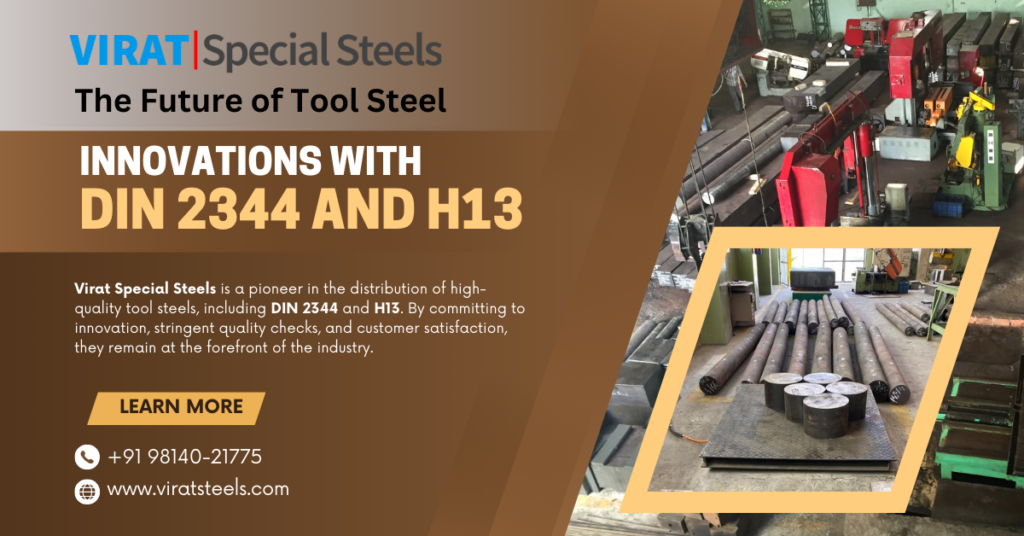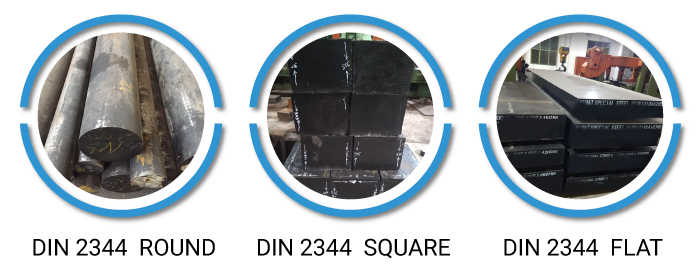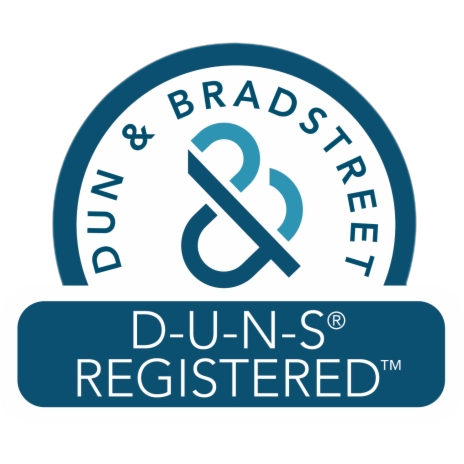Applications of DIN 2344 Steel
now browsing by category
The Future of Tool Steel: Innovations with DIN 2344 and H13
In the evolving world of manufacturing, the materials used to shape, mold, and cut have a direct impact on productivity and quality. Tool steels play a critical role in this landscape, with DIN 2344 and H13 standing out as industry leaders. Known for their exceptional thermal resistance, hardness, and strength, these grades are the backbone of tools, molds, and dies in industries such as automotive, aerospace, and die-casting. In this article, we’ll explore the significance of these materials, examine ongoing innovations, and understand how companies like Virat Special Steels contribute to shaping the future of tool steel.

The Role of Tool Steel in Manufacturing and Industry
Tool steels are indispensable for industries that demand precision and durability. Used extensively in the production of cutting tools, molds, and dies, these alloys must endure extreme conditions, from high temperatures to heavy wear. Without them, high-quality manufacturing would simply not be possible. Automotive industries rely on tool steels for die-casting, while aerospace engineering depends on these materials for components exposed to high temperatures and stresses. In short, tool steels are the unsung heroes enabling modern engineering feats.
What Makes DIN 2344 and H13 Stand Out?
Composition and Properties of DIN 2344
DIN 2344 is a chromium-molybdenum-vanadium alloyed steel prized for its high thermal resistance and toughness. It maintains hardness even at elevated temperatures, making it a preferred choice for hot-working tools like forging dies and extrusion presses. Key properties include:
- Exceptional wear resistance.
- High tensile strength.
- Excellent machinability.
Characteristics and Features of H13
H13 steel, part of the H-series family, is well-known for its versatility and toughness. It’s often chosen for die-casting and plastic mold tooling, thanks to its outstanding thermal fatigue resistance and ease of fabrication. Its main properties are:
- Superior thermal conductivity.
- Resistance to cracking under repeated heating and cooling cycles.
- High flexibility for complex shaping.
Innovations Driving the Future of Tool Steel
The tool steel industry has seen several groundbreaking advancements. Let’s delve into some of the most significant ones:
- Advanced Alloying Techniques
Researchers are experimenting with alloying elements like cobalt and niobium to improve the thermal and wear resistance of tool steels. Such innovations push the limits of performance. - Additive Manufacturing and 3D Printing
3D printing is revolutionizing tool steel production by enabling intricate designs and reducing material waste. Industries are now combining traditional methods with 3D technologies for optimal results. - Improved Heat Treatment Processes
Heat treatment plays a pivotal role in enhancing tool steel properties. Modern techniques such as vacuum hardening ensure precision in achieving desired hardness and toughness.
Advantages of Modern Tool Steel Innovations
New innovations in DIN 2344 and H13 steels offer several benefits:
- Durability: These steels withstand high temperatures and extreme pressures without significant wear.
- Longevity: Enhanced resistance to thermal fatigue and cracking translates into longer tool lifespans, reducing downtime and maintenance costs.
- Efficiency: Advanced manufacturing techniques improve energy usage and reduce material waste.
Comparing DIN 2344 and H13 Tool Steels
Below is a snapshot of their key differences:
| Property | DIN 2344 | H13 |
| Composition | Cr, Mo, V | Cr, Mo, Si, V |
| Thermal Resistance | High | Very High |
| Applications | Forging, extrusion | Die-casting, molds |
Applications of DIN 2344 and H13
Both steels are tailored to specific needs:
- DIN 2344: Ideal for extrusion tooling and hot forging, thanks to its resistance to thermal shock.
- H13: Perfect for plastic injection molding, die-casting, and high-temperature aerospace components.
Environmental Sustainability and Tool Steels
Modern practices focus on sustainability. From reducing energy-intensive processes to emphasizing recycling, the industry is working toward a smaller environmental footprint. The longevity of DIN 2344 and H13 further minimizes the need for replacements, aligning with eco-friendly goals.
Future Prospects of DIN 2344 and H13
As industries move toward automation and more advanced technologies, the demand for high-performing materials like DIN 2344 and H13 is set to rise. Innovations in metallurgy and 3D printing will only increase their applications.
Challenges in the Tool Steel Industry
Despite advancements, challenges persist. Manufacturers face supply chain disruptions, the rising cost of raw materials, and the need to balance quality with affordability. Addressing these challenges requires collective efforts from stakeholders, including suppliers like Virat Special Steels.
The Role of Companies Like Virat Special Steels
Virat Special Steels is a pioneer in the distribution of high-quality tool steels, including DIN 2344 and H13. By committing to innovation, stringent quality checks, and customer satisfaction, they remain at the forefront of the industry.
Key Takeaways
- Tool steels like DIN 2344 and H13 are integral to modern manufacturing.
- Innovations are enhancing their performance and extending their applications.
- Companies like Virat Special Steels are instrumental in meeting the growing demands of the industry.
FAQs About Tool Steel
- What makes DIN 2344 unique compared to other tool steels?
Its ability to maintain hardness at high temperatures and resist wear sets it apart. - Why is H13 preferred in certain industries?
H13 combines versatility and thermal fatigue resistance, making it ideal for die-casting and molds. - How does Virat Special Steels ensure the quality of its products?
Rigorous testing, advanced manufacturing techniques, and expert handling ensure top-notch quality. - Can DIN 2344 and H13 be recycled efficiently?
Yes, their high-grade compositions make them suitable for recycling without significant loss of quality. - What industries are likely to adopt future innovations in tool steels?
Automotive, aerospace, and renewable energy sectors will likely benefit the most.
Virat Special Steels is the largest Supplier & Stockiest of H13 Steel in India. Consult our team who will assist you for H-13/ DIN 2344 / AISI H13 steel query. https://www.viratsteels.com/h13.html
Size Range in Forged / Rolled Bars:
Rounds: 13mm Dia to 1500mm Dia
Rectangular: Thickness 13mm – 500mm / Width 13mm to 1500mm
For more information or to discuss your steel needs, Virat Special Steels invites you to reach out through their contact details provided, ensuring a professional and informative experience.
Any further queries feel free to contact us :
🌐https://www.viratsteel.in 📬 info@viratsteels.com ☎+91 98140-21775
Critical Applications of DIN 2344 Steel in the Automotive Industry!
Steel remains the backbone of the automotive industry, providing the strength and resilience required for modern vehicles. Among the various grades of steel used, DIN 2344 steel holds a prominent place due to its exceptional performance under challenging conditions. This article explores the critical applications of DIN 2344 steel in the automotive industry, showcasing why it is a preferred material for manufacturers globally.

What is DIN 2344 Steel?
DIN 2344 steel, also known as H13 tool steel, is a versatile, high-performance material widely utilized in hot work applications. Classified as a chromium-molybdenum steel alloy, it is specially engineered for superior heat resistance, toughness, and wear properties.
Key Properties of DIN 2344 Steel
- Thermal Resistance: With its ability to retain strength and hardness at elevated temperatures, DIN 2344 is perfect for high-heat environments.
- Toughness and Durability: Its superior toughness makes it resistant to cracking and deformation.
- Corrosion Resistance: With strong resistance against oxidizing environments, it outperforms many other alloys.
- Machinability: While challenging to machine, advanced processes have streamlined its incorporation in various automotive applications.
Importance of DIN 2344 Steel in Modern Industry
The global shift toward lightweight yet robust materials has spotlighted DIN 2344 steel, particularly in automotive manufacturing. With its combination of toughness and flexibility, it meets the demands of advanced production lines.
Relevance of DIN 2344 Steel in Automotive Manufacturing
1. Historical Context of Material Usage in Automotive Engineering
Steel has evolved over decades as the material of choice in automotive engineering. From basic carbon steels to high-alloy steels like DIN 2344, each advancement reflects a need to address emerging challenges, including efficiency, safety, and sustainability.
2. Why DIN 2344 is Perfect for the Automotive Sector?
The automotive industry faces constant pressure to produce durable, efficient, and lightweight vehicles. DIN 2344 steel meets these demands with its remarkable properties, offering enhanced strength for components that endure high-stress conditions.
Applications of DIN 2344 Steel in Automotive Components
- Use in Die Casting Tools: Die casting forms a vital part of automotive manufacturing, especially for producing lightweight engine and body components.
- Significance in Aluminum and Magnesium Alloy Casting. DIN 2344 steel excels in die-casting tools used for aluminum and magnesium alloys, offering superior wear resistance and prolonging tool life in high-temperature operations.
- Molds for Plastic Injection: As plastics gain traction in automotive design, durable molds made from DIN 2344 steel ensure precise shaping of components, contributing to reduced production defects and downtime.
- Hot Forming and Forging Applications: DIN 2344 steel is indispensable in hot forming and forging operations due to its ability to maintain hardness and strength even at elevated temperatures.
- Applications in Exhaust Systems and Engine Components:
- Enhanced Durability in High-Temperature Environments: From turbochargers to exhaust manifolds, DIN 2344 steel ensures resistance to thermal fatigue, ensuring reliability in extreme engine environments.
Benefits of Using DIN 2344 Steel
- High Wear Resistance: The wear resistance of DIN 2344 enhances the lifespan of tools and components, reducing frequent replacements and minimizing downtime.
- Excellent Thermal Stability: DIN 2344 steel maintains its structural integrity under high-temperature operations, a critical advantage for heat-intensive automotive processes.
- Corrosion Resistance: Superior resistance to oxidation and other corrosive agents ensures long-term durability, even under severe operating conditions.
- Cost-Effectiveness in Automotive Production: Reduced downtime, longer tool life, and enhanced product performance result in significant cost savings for manufacturers.
Challenges and Considerations
- Machining and Heat Treatment Challenges: While offering unmatched performance, DIN 2344 steel poses challenges in machining and heat treatment. Manufacturers must employ specialized techniques to overcome these hurdles.
- Alternatives to DIN 2344 Steel: In scenarios where DIN 2344 isn’t suitable, alternatives such as D2 or P20 steels might be considered based on specific application requirements.
Innovations and Future Applications
- Emerging Automotive Trends Impacting Material Choice: Electric vehicles and lightweight design trends are shaping the use of advanced steels, with DIN 2344 continuing to play a pivotal role.
- Future-Ready Technologies Enabled by DIN 2344 Steel: From 3D-printed automotive parts to precision components for EVs, the versatility of DIN 2344 opens pathways for innovative designs.
Sustainability and Environmental Impact
- How DIN 2344 Supports Energy Efficiency: The durability of DIN 2344 reduces waste in production, while its energy-efficient processing ensures environmentally friendly manufacturing practices.
- Recycling and Reusability in the Automotive Supply Chain: DIN 2344 steel components can be recycled and reused, supporting circular economy principles and reducing the industry’s carbon footprint.
Conclusion:
DIN 2344 steel stands as a cornerstone in the automotive industry, enabling the creation of high-performance vehicles and components. With its unique properties and adaptability, it continues to shape the future of manufacturing.
Mode of Supply
Virat Special Steels is the largest stockiest and supplier of DIN 2344 tool steel in flat, square and round bar. We provide steel in all sizes as your requirements. DIN 2344 die steel is available in flat, square and round shape. Consult our team who will assist you for DIN 2344 steel query.

FAQs
- What makes DIN 2344 steel ideal for the automotive industry?
Its exceptional heat resistance, wear resistance, and durability make it indispensable for high-stress applications like die-casting and forging tools. - Can DIN 2344 steel withstand extreme temperatures in engine systems?
Yes, DIN 2344 offers excellent thermal stability and is ideal for components in high-temperature environments, such as exhaust systems. - How does DIN 2344 steel contribute to cost-efficiency in manufacturing?
Its durability and wear resistance minimize tool replacement costs, reducing downtime and production expenses. - Are there eco-friendly aspects to using DIN 2344 steel in automotive production?
Yes, its recyclability and reduced waste in the production process support sustainable manufacturing practices. - What are the alternatives if DIN 2344 steel isn’t viable?
D2 or P20 steels are viable alternatives, depending on application needs and operating conditions.






